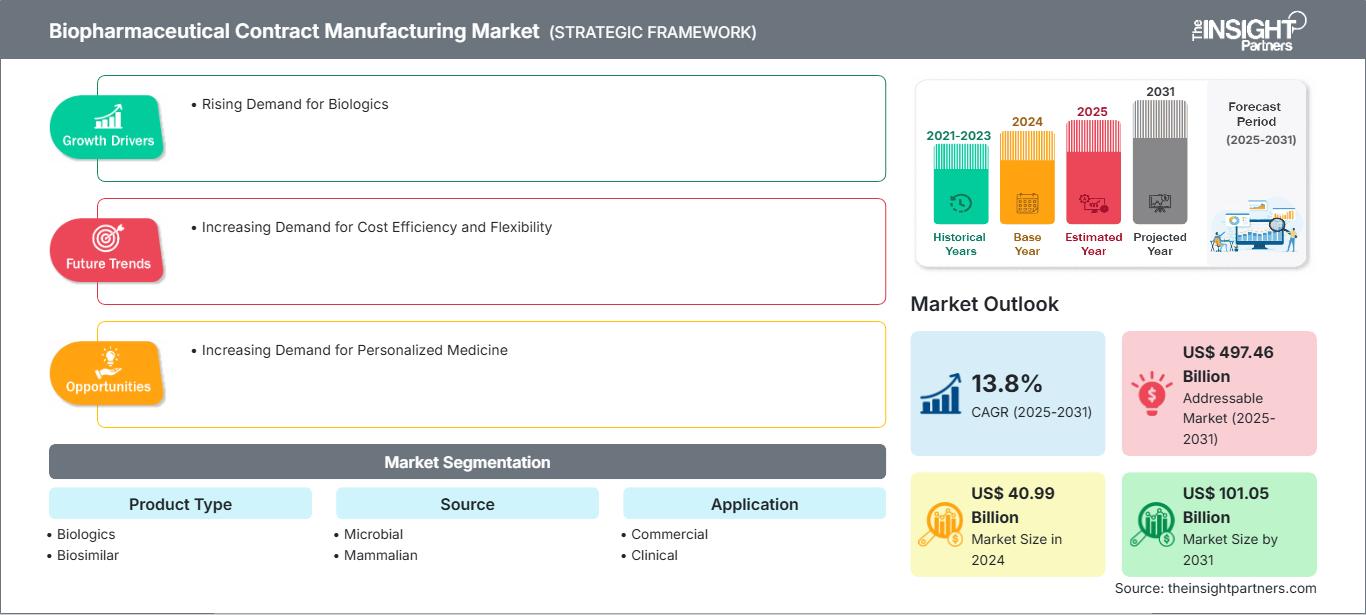预计到2031年,生物制药合同制造市场规模将从2024年的409.9亿美元增至1010.5亿美元。预计该市场在2025年至2031年期间的复合年增长率为13.8%。先进制造技术正在成为生物制药合同制造市场的一个重要趋势。
生物制药合同制造市场分析
由于对单克隆抗体、基因疗法和疫苗等生物制剂的需求不断增长,生物制药合同制造市场正在经历大幅增长,这需要专业的制造能力,促使制药公司将生产外包给合同制造组织(CMO)。连续加工、一次性系统和自动化等制造技术的进步提高了生产效率和可扩展性,使CMO能够满足生物生产的复杂需求。外包趋势的日益增长使企业能够专注于核心竞争力,同时降低运营成本和资本支出。此外,新兴市场医疗保健覆盖面的扩大,加上有利的监管环境,为合同制造商服务更广泛的客户群提供了新的机会。生物制药公司与合同生产组织 (CMO) 之间的战略合作伙伴关系和联盟促进了技术转移和流程优化,从而加快了产品开发和商业化进程。这些因素共同推动了全球生物制药合同制造市场的增长。
生物制药合同制造市场概览
由于对生物制剂、生物仿制药和复杂疗法的需求不断增长,全球生物制药合同制造市场正在加速发展。北美凭借强大的生物制药公司和监管支持,引领着市场。连续生产和机器人等技术进步正在提高生产流程的效率和可扩展性。此外,地缘政治变化促使企业实现供应链多元化,Syngene International 等印度公司正在美国扩大业务,以降低依赖中国制造业带来的风险。同样,欧洲的合同生产组织 (CMO) 也在生物制剂、细胞和基因疗法以及高效原料药 (API) 等高增长领域拓展产能。德国、法国和瑞士等国家凭借其完善的基础设施和创新驱动的生态系统继续保持领先地位,而包括波兰和匈牙利在内的中东欧新兴中心则凭借成本优势和不断增长的技术专长,正在获得发展动力。战略伙伴关系、监管协调以及政府的支持性政策,使欧洲成为端到端生物制药制造服务的多元化且竞争激烈的地区。
自定义此报告以满足您的要求
您将免费获得任何报告的定制,包括本报告的部分内容,或国家级分析、Excel 数据包,以及为初创企业和大学提供超值优惠和折扣
生物制药合同制造市场: 战略洞察

-
获取本报告的主要市场趋势。这个免费样本将包括数据分析,从市场趋势到估计和预测。
生物制药合同制造市场的驱动因素和机遇
生物制剂需求增长推动市场增长
生物制剂是现代医学的基础,因为它们在治疗癌症、自身免疫性疾病和遗传病等复杂慢性疾病方面疗效显著。单克隆抗体、疫苗、细胞和基因疗法以及重组蛋白是医疗服务中广泛使用的一些主要生物制剂。根据美国国家癌症研究所的数据,2022 年报告的癌症新发病例约为 2000 万例,癌症相关死亡人数为 970 万例。此类慢性疾病数量的增加带来了对生物制剂的需求,导致制药商与专门从事生物制剂制造能力的合同制造组织 (CMO) 之间的合作增加。
生物制剂制造是一个复杂的过程,需要高度专业化的设备、专业知识和设施。由于生物制剂自建生产设施生产周期长且成本高昂,外包显得尤为重要。CMO 提供必要的基础设施和专业知识,以实现规模化生产,使药物开发商无需大量资本投入即可满足市场需求。罗氏和百时美施贵宝等制造商在 CMO 的帮助下开发了基于单克隆抗体的生物制剂赫赛汀和欧狄沃,从而彻底改变了癌症治疗。这些疗法显著增加了对合同制造服务的需求,因为企业正在寻求能够大规模生产这些高度复杂生物制剂的专业设施。因此,生物制剂需求的不断增长催生了对专业化、经济高效且可扩展的生产解决方案的需求,从而推动了生物制药合同制造市场的增长。
个性化医疗需求增长,创造增长机遇
个性化医疗通过提供定制治疗方案,旨在满足个体患者独特的基因特征、环境和生活方式,从而提供了重要的发展机遇。由于基因组学、生物技术和诊断技术的进步,这种方法正被越来越多地采用,从而实现更精准、更有效的治疗。个性化医疗的不断发展催生了对专业化、灵活且可扩展的生产解决方案的需求。这些发展也促进了与CMO的合作,以将这些疗法推向市场。个性化疗法通常需要定制化的方法,这些方法涉及更灵活的生产流程,包括基因疗法、细胞疗法和精准肿瘤治疗。因此,生物制药公司越来越多地转向能够提供专业知识和能力来满足这些专业生产需求的CMO。
个性化医疗需求的不断增长凸显了对高效、可扩展的生产流程的需求,这些流程可以适应高度个性化治疗的生产。例如,Kymriah(由诺华公司开发)和Yescarta(来自吉利德)等基因疗法都是已成功开发和商业化的个性化药物。拥有合适基础设施的CMO可以提供这些疗法,因为它们需要独特的生产流程。此外,能够提供细胞疗法或基因编辑技术(例如基于 CRISPR 的疗法)生产专业服务的 CMO 有望从个性化医疗趋势中获益。随着企业向更小批量、更灵活和更定制化的方向发展,CMO 在确保这些疗法高效且经济地生产方面发挥着至关重要的作用,从而在预测期内为市场创造了丰厚的利润。
生物制药合同制造市场报告细分分析
生物制药合同制造市场分析的基础是产品类型、来源、应用和治疗领域。
- 根据产品类型,生物制药合同制造市场分为生物制剂和生物仿制药。生物制剂领域在 2024 年占据了更大的市场份额。
- 就来源而言,生物制药合同制造市场分为微生物和哺乳动物。 2024年,微生物领域占据了市场主导地位。
- 根据应用,生物制药合同制造市场分为商业和临床。2024年,商业领域占据了更大的市场份额。
- 按治疗领域,市场分为肿瘤学、自身免疫性疾病、呼吸系统疾病、代谢性疾病、神经病学、传染病和其他。2024年,肿瘤学领域占据了生物制药合同制造市场份额的主导地位。
按地区划分的生物制药合同制造市场份额分析
生物制药合同制造市场报告的地理范围分为五个区域:北美、亚太地区、欧洲、中东和非洲以及南非。中美洲。
2024年,北美占据了相当大的市场份额。北美全球生物制药合同制造市场的增长得益于其成熟的制药行业、先进的技术基础设施以及支持创新和高质量制造的强大监管框架。美国凭借其庞大的制药基地、高额的研发投入以及重要的合同开发和制造组织(CDMO)的存在,仍然占据主导地位。加拿大也在拓展其能力,尤其是在利基生物制剂和无菌制造领域。制药公司外包趋势的增长降低了成本并加快了产品上市时间,进一步推动了该地区生物制药合同制造市场的发展。
生物制药合同制造市场区域洞察
The Insight Partners 的分析师已详尽阐述了预测期内影响生物制药合同制造市场的区域趋势和因素。本节还讨论了北美、欧洲、亚太地区、中东和非洲以及南美和中美洲的生物制药合同制造市场细分和地域分布。
生物制药合同制造市场报告范围
| 报告属性 | 细节 |
|---|---|
| 市场规模 2024 | US$ 40.99 Billion |
| 市场规模 2031 | US$ 101.05 Billion |
| 全球复合年增长率 (2025 - 2031) | 13.8% |
| 历史数据 | 2021-2023 |
| 预测期 | 2025-2031 |
| 涵盖的领域 |
By 产品类型
|
| 覆盖地区和国家 |
北美
|
| 市场领导者和主要公司简介 |
|
生物制药合同制造市场参与者密度:了解其对业务动态的影响
生物制药合同制造市场正在快速增长,这得益于终端用户需求的不断增长,而这些需求的驱动因素包括消费者偏好的演变、技术进步以及对产品优势的认知度的提升。随着需求的增长,企业正在扩展产品线,不断创新以满足消费者需求,并抓住新兴趋势,从而进一步推动市场增长。

- 获取 生物制药合同制造市场 主要参与者概述
生物制药合同制造市场新闻及最新发展
生物制药合同制造市场的评估是通过收集一手和二手研究后的定性和定量数据进行的,这些数据包括重要的公司出版物、协会数据和数据库。市场中的一个关键发展如下:
- 龙沙完成对罗氏公司位于美国瓦卡维尔的大型生物制剂生产基地的收购。(来源:龙沙,新闻稿,2024 年 10 月)
- Sutro Biopharma 与勃林格殷格翰 BioXcellence 合作:在商业规模上建立了一流的无细胞生产能力。(来源:Sutro Biopharma, Inc.;新闻稿,2025 年 1 月)
- 勃林格殷格翰增强在中国的生物制药合同制造服务。 (来源:勃林格殷格翰国际有限公司,新闻稿,2025 年 3 月)
生物制药合同制造市场报告覆盖范围和可交付成果
《生物制药合同制造市场规模和预测(2021-2031)》报告对市场进行了详细的分析,涵盖以下领域:
- 涵盖范围内所有主要市场领域的全球、区域和国家/地区生物制药合同制造市场规模和预测
- 生物制药合同制造市场趋势和市场动态,例如驱动因素、限制因素和关键机遇
- 详细的 PEST 和 SWOT 分析
- 生物制药合同制造市场分析,涵盖主要市场趋势、全球和区域框架、主要参与者、法规和最新市场发展
- 行业格局和竞争分析,涵盖市场集中度、热图分析、知名参与者和最新发展生物制药合同制造市场
- 详细的公司简介
- 历史分析(2 年)、基准年、预测(7 年)及复合年增长率
- PEST和SWOT分析
- 市场规模、价值/数量 - 全球、区域、国家
- 行业和竞争格局
- Excel 数据集
近期报告
相关报告
客户评价
购买理由
- 明智的决策
- 了解市场动态
- 竞争分析
- 客户洞察
- 市场预测
- 风险规避
- 战略规划
- 投资论证
- 识别新兴市场
- 优化营销策略
- 提升运营效率
- 顺应监管趋势






















 获取免费样品 - 生物制药合同制造市场
获取免费样品 - 生物制药合同制造市场